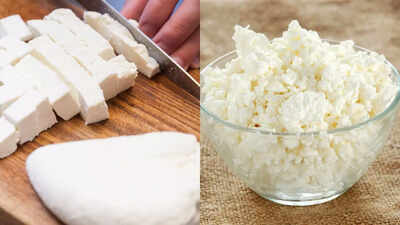
Dairy products have always been an integral part of human diets, offering essential nutrients like protein, calcium, and vitamins. Among them, paneer and cottage cheese stand out as two of the most popular fresh cheeses. While both are derived from milk and share certain nutritional qualities, they are quite different in terms of preparation, texture, flavor, and culinary applications. In India, paneer dominates traditional dishes, whereas cottage cheese has gained popularity in Western diets. Understanding the differences between paneer and cottage cheese can help people make healthier food choices and select the right cheese for specific recipes.
Understanding difference between paneer and cottage cheese
Paneer is a staple in Indian households and restaurants. It is made by curdling hot milk with lemon juice, vinegar, or yogurt. Once the curds are formed, they are drained and pressed into a solid block. This pressing process removes most of the whey and gives paneer its firm, dense, and slightly chewy texture.
Paneer has a mild flavor, which allows it to absorb spices and seasonings easily. This makes it a versatile ingredient for curries, stir-fries, and tandoor dishes. Popular Indian recipes like paneer tikka, palak paneer, and shahi paneer highlight its ability to enhance flavors while providing richness and nutrition.Cottage cheese, by contrast, is widely consumed in Western countries and is recognized for its soft, creamy, and slightly tangy taste. It is made by curdling milk with an acidic agent such as lemon juice, vinegar, or citric acid. Unlike paneer, cottage cheese is not pressed. The curds remain loose and moist, and in many cases, cream is added to enhance texture and richness.Cottage cheese is commonly eaten as a high-protein snack, used in salads, blended into smoothies, or spread on bread and crackers. Its tangy, refreshing flavor makes it suitable for light, cold dishes and desserts rather than heavy cooked meals.
Key differences in preparation: Paneer vs cottage cheese
The main distinction between paneer and cottage cheese lies in the processing method. Paneer undergoes pressing, which removes excess whey and gives it a compact structure. This firmness allows paneer to hold its shape during frying, grilling, or cooking in gravies.Cottage cheese, on the other hand, retains much of its moisture since it is not pressed. Its soft consistency makes it unsuitable for frying or grilling, but ideal for mixing into cold or semi-cooked dishes. Another important difference is the type of milk used—paneer is usually prepared from whole milk, whereas cottage cheese is often made from low-fat or skim milk. This impacts both texture and nutritional content.
Nutritional comparison: Protein vs fat
Both paneer and cottage cheese are excellent sources of protein and calcium, making them beneficial for muscle strength and bone health. However, their macronutrient profiles differ:
- Paneer: Higher in fat and calories due to its whole-milk base. This makes it energy-dense and suitable for people looking to gain weight or include more richness in their diet.
- Cottage Cheese: Typically lower in fat and calories, especially when made from skimmed or low-fat milk. It often provides slightly more protein per serving, making it a popular choice among athletes and those following weight-loss or high-protein diets.
The choice between the two often comes down to dietary goals. Those aiming for a lean diet may prefer cottage cheese, while those wanting richer meals may opt for paneer.
How paneer and cottage cheese are used in recipes
- Paneer’s firm texture and ability to absorb spices make it ideal for Indian cooking. It can be cubed, grilled, fried, or simmered in flavorful gravies without losing shape. Dishes such as paneer butter masala, paneer bhurji, and paneer pakora showcase its adaptability.
- Cottage cheese, being creamy and tangy, works best in cold preparations. It is commonly used in salads, pasta, dips, spreads, pancakes, and desserts. While cottage cheese can replace paneer in certain uncooked recipes, it cannot serve as a substitute in curries or grilled dishes due to its soft texture.
Choosing the right cheese for your diet and recipes
Although paneer and cottage cheese come from the same base ingredient—milk—they serve different purposes in cooking and nutrition. Paneer is dense, rich, and better suited for traditional Indian recipes, while cottage cheese is lighter, tangier, and ideal for modern, low-fat, and protein-focused diets.The choice ultimately depends on individual preferences and dietary needs. Those who enjoy spicy curries and grilled delights may prefer paneer, while those seeking a low-calorie, protein-packed option may lean toward cottage cheese.Also Read | This simple clove trick keeps rice fresh, aromatic, and protected from insects; every Indian kitchen swears by it








